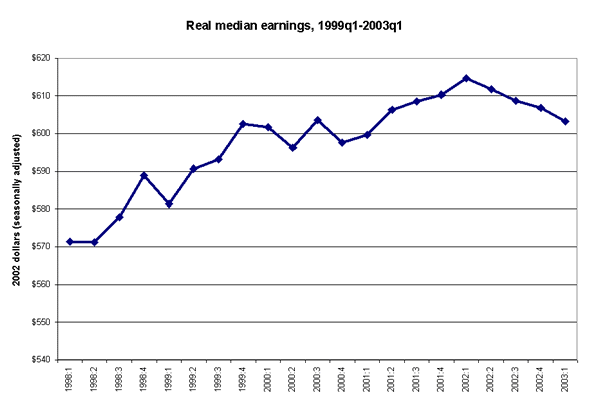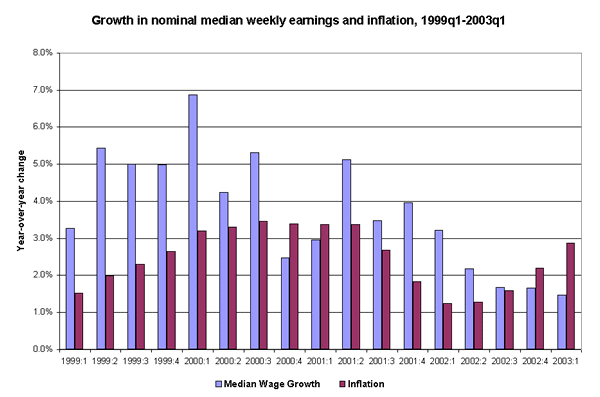Snapshot for April 30, 2003.
Jobless recovery catches up to wages
Each quarter, the Bureau of Labor Statistics (BLS) publishes the median weekly earnings of full-time workers. After stagnating across much of the 1980s and early 1990s, median weekly earnings grew sharply in inflation-adjusted terms in the late 1990s, when the tight labor market led employers to bid up wages for middle- and low-wage workers. Lately, however, that unemployment effect has been working in reverse, with a weaker labor market leading to slower wage growth. At the same time, inflation, which has been quite tame over the recession, has grown more quickly, largely due to faster growth of energy prices.
As shown in the next two graphs, these trends in slower wage growth and increased inflation have led to persistent real wage losses for the median earner over the past year. The top graph shows the real value of median weekly earnings from the first quarter of 1998 to the first quarter of 2003. Median earnings grew fairly consistently over the last years of the economic boom, and even through 2001, as the momentum of the formerly tight labor market coupled with decelerating prices kept real wages on the rise. But these favorable trends appear to have reversed last year, and real earnings fell steadily over the past four quarters.


The second graph shows how this result stems from both slower earnings and faster inflation. The graph’s lighter bars represent year-over-year nominal earnings growth, and the dark bars are price growth measured over the same period. The deceleration of annual earnings growth clearly begins in 2002q1and continues through the most recent quarter (2003q1). At the same time, after growing more slowly from mid-2001 through mid-2002, inflation is growing faster now, leading to real losses for the median earner.
Price growth may slow if energy prices come down, but earnings are unlikely to accelerate given that unemployment is expected to remain high. Thus, even with inflation rates that prevailed a year ago, real median earnings will likely remain stagnant at best.
Other data trends also reflect these declines in the earnings of full-time job holders. For example, the widely observed hourly earnings of production, non-supervisory workers grew 3.1% from 2002q1 to 2003q1, 0.2% ahead of inflation (over the previous year, this series grew 2.3% in real terms). Furthermore, the most recent data from the employment cost index show nominal private sector wages and salaries growing 3.0% from 2002q1 to 2003q1, compared to 3.5% and 3.8% in the prior two years. Clearly, high unemployment has caught up to earnings growth.
Source: The earnings data are released quarterly by BLS (see ftp://ftp.bls.gov/pub/news.release/History/wkyeng.04172003.news for most recent release). Data for the top figure have been seasonally adjusted by the author. Note that the nominal earnings changes include the revised data point for 2002q1 (incorporating re-weighting based on Census 2000 results), as this is compared to the revised data point for 2003q1. The seasonally adjusted figure does not include the revised data point for 2002q1 since BLS has yet to revise other neighboring values. The graphs are from an upcoming EPI Issue Brief on recent wage trends written by Jared Bernstein and Lawrence Mishel.
This week’s Snapshot by EPI economist Jared Bernstein, with research assistance by Brendan Hill.
Check out the archive for past Economic Snapshots.
